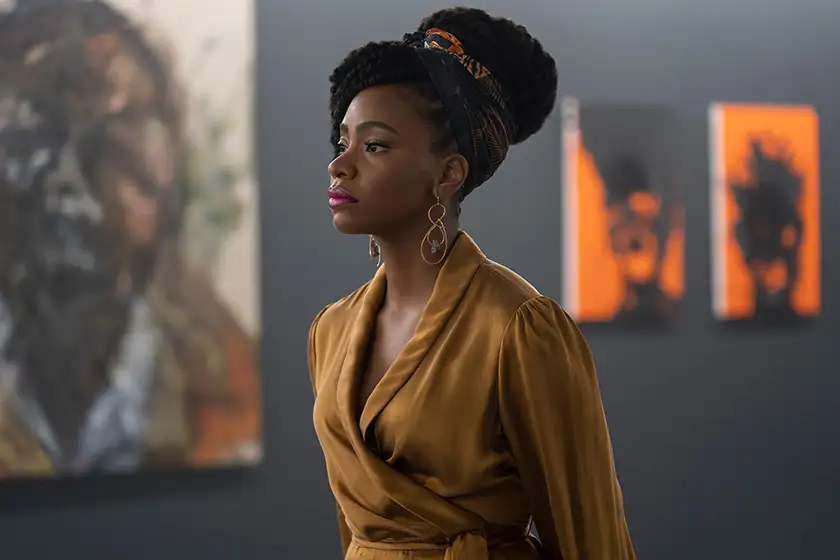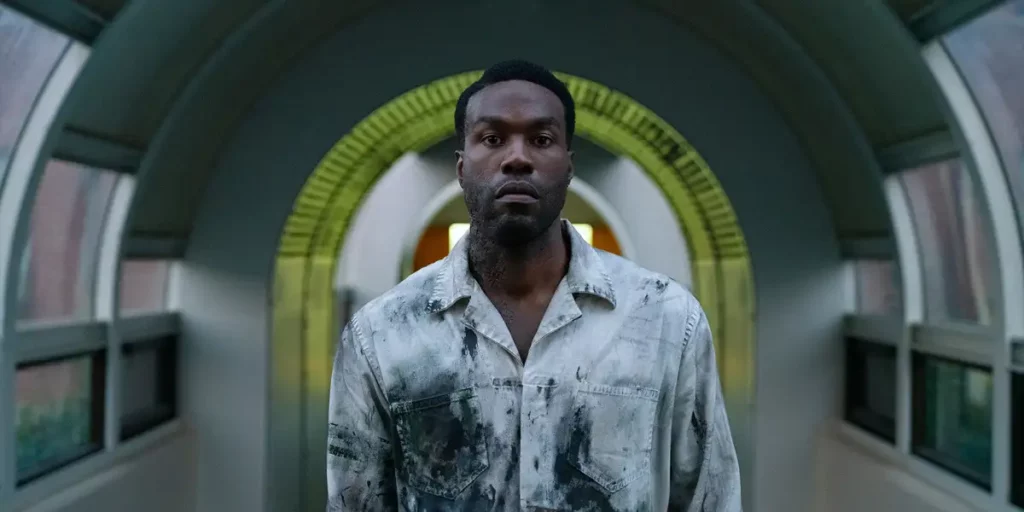Candyman (2021) has style to spare in its horror set pieces, but the script is far too cluttered and confusing for its social commentary to land.
Sure, when thinking of iconic horror slashers, Candyman might not be the first guy that comes to mind. Off the top of their head, a fan could name Jason, Michael, or Freddy before ever even thinking of Tony Todd’s chilling character from the 1992 film of the same name. However, just because Candyman hasn’t enjoyed the same enduring adoration those three aforementioned terrors have experienced in the horror community doesn’t diminish the continuing cultural significance of that classic in any capacity. A movie about the spirit of the son of a slave who fell in love/fathered a child with a wealthy white woman whose father subsequently had him maimed by a lynch mob, dooming him to haunt the setting in which he was slain and all of the modern-day Black Americans who inhabit it? Yeah, that’s not at all relevant in a country still plagued by the pains of its racist past and the ways that prejudice infests our politics today.
Sarcasm aside, writer-director Nia DaCosta (Little Woods, The Marvels) – with an assist from co-writer/producer Jordan Peele, of Get Out and Us fame – took notice of Candyman’s still startling relevance in the time of Donald Trump and Black Lives Matter and set off to make the subtext of the original film the central focus of their 2021 legacyquel. While hopes were high, unfortunately, in attempting this audacious adaptation, the epic gothic elegy lost its edge, leaving an incoherent and inferior imitation in its wake.
Candyman (2021) returns to the housing projects of Chicago’s Cabrini Green neighborhood, first explored in the franchise by Virginia Madsen’s Helen Lyle nearly three decades ago. This time around though, the Cabrini towers have been torn down, and the neighborhood as a whole has been gentrified beyond recognition, now called home by a horde of upwardly mobile millennials, with two of these individuals being visual artist Anthony McCoy (Yahya Abdul-Mateen II, of Aquaman and HBO’s Watchmen) and his girlfriend, art gallery director Brianna Cartwright (Teyonah Parris, of If Beale Street Could Talk and WandaVision).
While Brianna soon gains a following in the area thanks to her eye-catching galleries, Anthony’s painting career has come across some obstacles, leaving him straining to match his prior successes. That is, until he crosses paths with the cryptic William Burke (Colman Domingo, of Ma Rainey’s Black Bottom and Zola), a former Cabrini Green resident who tells him the tragic tale of “the Candyman.” Instantly inspired, Anthony begins to adapt this story through the art he crafts in his studio, but as he digs deeper into the history of this horror and the grief it brought to Cabrini Green, he unearths secrets he can’t soon forget and finds himself caught in Candyman’s crosshairs.

Let’s start with the positives: clearly, Nia DaCosta has the directorial vision of a true auteur, and if you take anything away from Candyman, it should be that she’s a tremendous talent on the rise with something to say and the bonafides to back herself up. Even when the screenplay inevitably stumbles, DaCosta’s grip on the grim aura of the film is unwavering, and she proves to be undeniably proficient at inventing peculiarly petrifying imagery that hasn’t previously been seen in the horror genre.
Though some of Candyman’s most macabre kills feel disconnected from the film’s central story, there’s no denying that these sequences are suitably spine-chilling and wondrously well-crafted. From gory massacres in art galleries to a brutal bloodbaths in high school bathrooms, DaCosta continually finds ways to make possibly stereotypical slayings subversive and visually stimulating by playing around with perspective and being calculated with the film’s camerawork. Likewise, her decision to depict flashbacks about the morbid Candyman mythos through shadow puppetry is a captivating choice aesthetically that further adds to the movie’s mystifying mood – a clear sign of a creator who knows which “styles” best complement the feel of her film and maximize its impact.
Candyman’s cast is largely commendable as well, rising above the occasionally overwrought narrative with their grounded characterizations, which is all the more impressive given how little time the story spends on character development. Abdul Mateen’s Anthony may have a rather odd journey overall, but the acclaimed actor finds an entry point into the pathos of this part regardless, and he’s particularly brilliant with the body horror that materializes as the movie goes on, selling some of the most distressing displays spectacularly. Parris, hot off a standout supporting role in the MCU’s hit Disney+ show WandaVision, makes for a fantastic female lead and formidable “final girl” here, convincing us of Brianna’s chemistry with Anthony and adding credence to this connection’s status as the emotional core of the film while also holding her as more horrors arise in the frenetic finale.
Nathan Stewart-Jarrett (The Kid Who Would Be King, Hulu’s Four Weddings and a Funeral) nearly steals the show as Brianna’s gay and gabby brother Troy, while Vanessa Williams, reprising her role from the original film, gets the best scene in the entire endeavor during a ruinous reunion with Anthony, her son. Sadly, Domingo is the only cast member who gets the short end of the stick, as, try as the actor might, he’s hobbled by a ridiculously written role that can’t hold up to the slightest scrutiny.
And that’s when the negatives kick in: as a whole, Candyman is just simply never as coherent as it thinks it is, with a script that strains to connect the titular character to the social commentary it’s trying to convey to its audience. Make no mistake – Candyman has been and always will be a sociopolitical symbol, but the original film dealt with these topics in a far subtler and sophisticated manner, and that’s where this legacyquel stumbles. Not only does it approach modern social ailments with next-to-no nuance, but it also can’t quite make up its mind on what issues it wants to prioritize and what it wants to say about these subjects. You can sense the passion and pain infused in the project in every scene, but there’s little to emotionally latch onto when the film’s societal critique is this cluttered.
Questions about topics like gentrification and the exploitation of Black trauma in art are raised and then never touched on again, making it impossible to leave the movie with any meaningful takeaways. At one point, Candyman even suggests that Anthony and Brianna are gentrifiers too, moving into a masterfully furnished new home that doesn’t hide their (or Brianna’s) wealth whatsoever. And in another moment, it seems to come down on Anthony for basing so much of his work around the brutality faced by Black Americans, as if their daily agony wasn’t enough. And yet, the movie refuses to come out and give its honest opinion on these two, leaving us in the dark to wonder if they’re victims we should pity for being caught in Candyman’s path, or if they deserve this spiritual suffering.
In a more well-realized work, such a storytelling choice could be seen as admirably ambiguous; here, it just feels like essential information is frustratingly left out. Case in point, we just never truly know anything about these characters beyond their professions and their most obvious romantic or familial relations to one another, and disappointingly, it seems as if this crucial insight might have been left on the cutting room floor. For example, in the middle of the film, two scenes make reference to Brianna’s fraught relationship with her late father – a part of her past that has never been mentioned prior and is never mentioned again, despite priming audiences to wait for a payoff. If this plot point is so visibly left unresolved in the final feature, one has to wonder how many similar story arcs never saw the light of day at all, which brings us to another issue – Candyman’s rushed runtime. At barely 90 minutes long, there’s simply not enough time to do all of the film’s colorful characters or its copious social criticism justice, and this is most felt in the tremendously truncated third act, which includes a head-scratching heel turn and the movie’s most blatantly political set piece all in the span of ten minutes, giving neither of these momentous moments the time to breathe (and rendering the former incomprehensible).
The story also can’t ever settle on one read of its titular terror either. He starts off as a “misunderstood monster,” accused of crimes he didn’t commit (at least in this version) and unfairly pummeled by police. However, later on, we see, via flashback, that he’s responsible for the murders of multiple young Black children in his supernatural form – and why would this tragic figure, personifying the pain of the Black community, take out his anger on his own race? Finally, in the film’s chaotic climax, the “Candyman” is almost a superhero-of-sorts for Black Chicagoans, dispatching those who would do them harm. It feels like Peele and DaCosta want to say that Candyman is a character who can be many things to many different people, depending on who’s telling the story, but they don’t connect the dots well enough to make this argument, and they merely muddy their messaging as a result. He’s everything and nothing at the same time. Do we cower in fear when we hear his name or cheer him on as he “battles police brutality”? The film never communicates who or want Candyman really is, and, once again, this isn’t “artfully ambiguous” – it comes across as apathy.
Candyman isn’t ever truly terrible, but given how much promise the picture had – especially being “re-envisioned” for today’s tumultuous troubles with race relations – it should be so much better than it ultimately is. Although Nia DaCosta’s daring direction and the cast’s continual commitment make the movie watchable, its maddeningly messy script squanders its chance to convey some scathing and significant social commentary, leaving us wondering what the point was in revisiting this series at all.
Candyman (2021) is now available to watch on digital and on demand

